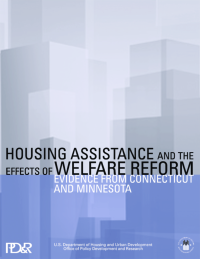Housing Assistance and the Effects of Welfare Reform
Evidence from Connecticut and Minnesota
The fact that many of the people living in public or other government-subsidized housing are also welfare recipients means that the progress that those tenants make toward self sufficiency may be substantially influenced by the performance of mainstream (that is, non-housing) welfare-to-work programs and policies. Conversely, the fact that many welfare recipients receive government housing assistance (over 30 percent nationally, but much higher in some cities) means that the responses of subsidized tenants may influence the overall accomplishments of welfare reform initiatives. Only recently, however, have studies begun to explore the relationship between housing status and the effectiveness of welfare policies. A better understanding of this relationship may be important to continued efforts to increase economic self -sufficiency in both the assisted housing and the welfare policy arenas.
This study, sponsored by the U.S. Department of Housing and Urban Development (HUD), adds to a small but growing body of literature on this topic. It focuses on the following key questions:
- Are the welfare recipients who receive housing assistance a harder-to employ group than the recipients who do not receive housing subsidies?
- Are the welfare reform initiatives any more effective or less effective for welfare recipients who receive housing assistance than for those who do not?
- Does the effectiveness of the welfare reform initiatives vary for recipients who receive different types of housing subsidies?
- Is there a statistical relationship between receipt of housing assistance for welfare recipients and subsequent success in the labor market?
To answer these and other questions, the study uses data from two random assignment welfare reform experiments for which reasonably complete housing data are available: the Connecticut Jobs First program (Jobs First) and the Minnesota Family Investment Program (MFIP). These initiatives sought to increase self-sufficiency among recipients of cash assistance under the federal Temporary Assistance for Needy Families (TANF) program, which in 1996 replaced Aid to Families with Dependent Children (AFDC). Although the two initiatives differ in important ways, together they encompass a broad array of policy-relevant innovations, including employment services, participation mandates, financial incentives to work, and welfare time limits. This study combines self-reported information provided by individuals when they entered these studies with data from HUD’s own administrative records in order to classify the sample members according to their housing status.







